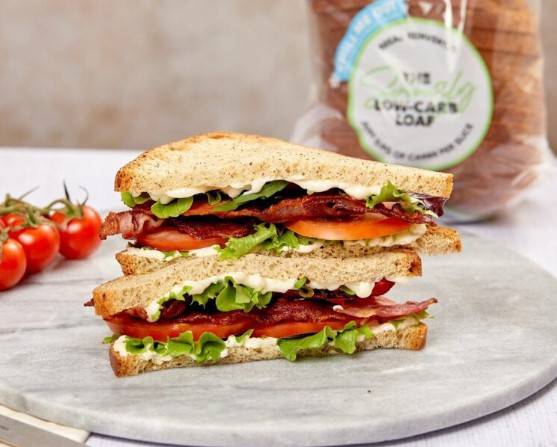In recent years, the gratitude of low-carb diets has soared, stimulating many to seek more healthy replacements for standard bread. This surge in attention has given an upward push to a brand-new contributor in bread recreation: low-carb bread. It offers a promising answer for those aiming to shrink their carb-feasting without bidding farewell to the valued staple of many diets. In this guide, we’re going to take a better look at what low-carb bread is, why it is ahead of traction, and the way it could match impeccably into your nutritional lifestyle. Whether you’re a pro-low-carb fanatic or humbly dipping your toes into the fashion, be a part of us as we discover the world of breaking bread the low-carb way.
Role of Low-Carb Bread in Weight and Blood Sugar Control
Weight Management
When it involves weight control, low-carb bread offers a promising answer. By containing fewer carbohydrates and calories than conventional bread, it can assist people adjust their calorie intake extra efficiently. Additionally, the higher protein and fiber content in low carb bread can make a contribution to expanded emotions of fullness and satiety, potentially decreasing usual food intake. This may be especially useful for the ones trying to achieve or hold a healthy weight.
Blood Sugar Control
One of the important advantages of low-carb bread is its capability to aid in blood sugar control. Carbohydrates are the number one macronutrient responsible for raising blood sugar ranges after food. By lowering carbohydrate intake, low-carb bread can help stabilize blood sugar levels, making it a treasured choice for people with diabetes or those aiming to prevent spikes in blood glucose. Choosing low-carb bread over traditional bread may assist in adjusting insulin response, leading to higher glycemic control through the years.
Potential Impact on Energy Levels
Energy Levels
Many people fail experiencing more regular power levels once they devour fewer carbohydrates, which includes the ones determined in Keto friendly bread. Unlike the short-strength spikes accompanied by crashes associated with excessive-carb meals, low-carb alternatives can provide a steadier source of power. By keeping off the rapid fluctuations in blood sugar tiers that frequently accompany carbohydrate-rich foods, individuals may also revel in sustained strength tiers, assisting them to feel more alert and focused for the day.
Overall Well-being
The effect of low-carb bread on common well-being extends beyond energy tiers. For some humans, lowering their carbohydrate intake can lead to upgrades in temper, awareness, and even high sleep. By selecting low-carb options, people may additionally experience fewer strength crashes, reduced cravings for sugary meals, and improved mental readability. Additionally, the capacity advantages of stabilizing blood sugar stages and helping weight management can contribute to a sense of ordinary well-being and energy.
Comparison of Low-Carb Bread Brands

Choosing the proper low-carb bread may be hard with the multitude of options available on the market. Here, we will compare numerous famous manufacturers primarily based on taste, texture, substances, and dietary fees to help you make a knowledgeable choice.
- Taste: Many customers praise Brand A for its delicious flavor, frequently evaluating it favorably to standard bread.
- Texture: The texture of Brand A’s low-carb bread is regularly defined as gentle and fluffy, reminiscent of conventional white bread.
- Taste: While opinions on Brand B’s flavor vary, many clients appreciate its hearty, complete-grain taste.
- Texture: Brand B’s bread has a tendency to have a denser texture in comparison to conventional bread, which a few purchasers decide upon.
- Ingredients: Brand B orders natural substances containing flaxseed meal, oat fiber, and wheat protein to detach in its low-carb bread recipe.
Step-by-Step Instructions for Making Low-Carb Bread at Home

Gather Your Ingredients
Before you begin, gather all the substances you may need for your selected low-carb bread recipe. This guarantees you have the entirety on hand and geared up to move.
Preheat Your Oven
Heat your oven to the temperature stated in your recipe. This lets the oven reach the desired temperature by the time you’re ready to swelter your bread.
Prepare Your Loaf Pan
Grease your loaf pan or line it with parchment paper to save the bread from sticking for the duration of baking. This step ensures easy elimination of the bread as soon as it is completed.
Mix Dry Ingredients
In a huge blending bowl, integrate all the dry substances laid out in your recipe. This usually includes flour, baking powder, salt, and any additional dry elements like seeds or nuts.
Mix Wet Ingredients
In a separate bowl, whisk collectively all the wet substances called for your recipe. This generally includes eggs, melted butter or oil, and any liquid elements, which include milk or vinegar.
Combine Wet and Dry Ingredients
Gradually add the moist ingredients to the dry components, stirring lightly until just mixed. Be careful no longer to overmix, as this may result in a dense or hard texture.
Transfer the batter to a Loaf Pan
Pour the batter into your prepared loaf pan, spreading it calmly with a spatula to ensure an excellent upward push in the course of baking.
Tips for Incorporating Low-Carb Bread into Your Diet
Swap Out Traditional Bread:
Replace straight bread with low-carb bread in your preferred sandwiches, toast, and wraps. Whether you are making a traditional PB
Use It as a Base for Breakfast:
Start your time without working correctly through the use of low-carb bread as a base for breakfast dishes like avocado toast, egg sandwiches, or French toast. These delicious replacements offer a hearty and refreshing start to your morning without the carb excess.
Get Creative with Toast Toppings:
Experiment with a number of toppings to add taste and feel to your toast. Try pounded avocado with sliced tomatoes and a sprinkle of feta cheese, almond butter with divided bananas and a drizzle of honey, or ricotta cheese with berries and a drizzle of balsamic coating.
Make Low-Carb Croutons:
Transform waste low-carb bread into crispy croutons to piece crunch in your salads or soups. Cube the bread, toss it with olive oil and your favorite seasonings, and bake till golden brown and crispy.
Benefits of Low-Carb Bread
Low-calorie bread isn’t always only a modern-day alternative to traditional bread; it also offers a range of capacity health benefits.
Weight Management
Best Low carb bread usually incorporates fewer carbohydrates and energy than old-fashioned bread,
making it a suitable best for the ones looking to accomplish their weight.
Blood Sugar Control:
By decreasing your consumption of carbohydrates, low-carb bread can assist in stabilizing blood sugar ranges, making it a clever choice for individuals with diabetes or those aiming to prevent spikes in blood glucose.
Increased Satiety
Despite containing fewer carbs, low-carb bread can still be filling, thanks to its higher protein and fiber content material. This assists you in feeling satisfied for longer periods, potentially reducing standard Low-calorie breads.
Improved Energy Levels
Some people record experiencing extra steady energy levels during the day when they consume fewer carbohydrates, which may be attributed to avoiding the energy crashes often related to high-carb meals.
Enhanced Nutritional Profile
Many varieties of low-carb bread are fortified with additional vitamins, which include nutrients, minerals, and omega-three fatty acids, providing an additional nutritional boost compared to standard bread.
Conclusion
In the end, low-carb bread gives a delicious and nutritious opportunity to conventional bread, making it easier than ever to include a low-carb lifestyle. By incorporating the Low sodium Bread into your eating regimen, you could enjoy all the blessings of a discounted carb intake without sacrificing taste or satisfaction. From its position in weight control and blood sugar manipulation to its potential effect on power stages and standard well-being, low-carb bread has lots to provide for those seeking to prioritize their health and health. By exploring the various range of low-carb bread brands, experimenting with self-made recipes, and incorporating creative serving ideas into your meals and snacks, you can seamlessly integrate low-carb bread into your everyday routine.



